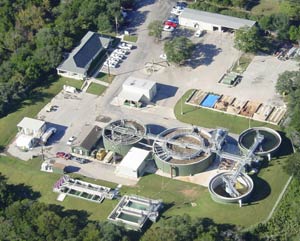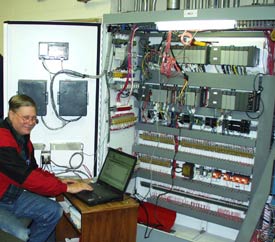|
|
||||||
|
||||||
Industries
Industries: Water/Wastewater
Lakeway Municipal Utility District
Rockwell, TEI & Data-Linc control expanding waste-lines and water demands
By Karen Perlbachs, MarCom Manager, Data-Linc Group
John Gordon, Senior Engineer for Design/Development, TEI Controls
| Abstract- From 1972 to 2006, Lakeway Municipal Utility District near Austin, Texas, had increased not only in size but also in water/wastewater management sophistication. The updated system closes the data accessibility gap, eliminates recurring costs and provides a cost-effective system that meets current needs while providing built-in expandability for future growing demands. (Download the four page 1.8 MB pdf print quality version.) |
Background
 |
| Lakeway's facility is located west of Austin, Texas. |
To economically expand the legacy system, close the data acquisition gap and allow for future growth, the engineers designed a SCADA (Supervisory Control And Data Acquisition) system that interfaced phone line modems with Allen-Bradley Programmable Logic Controllers (PLCs). The SCADA system consisted of one local operator workstation site at the District Office linked to one PLC and one remote PLC site. Local and remote sites were connected by dedicated full duplex telephone modems.
As the community water needs grew so did Lakeway. In 1996, the SCADA system added an operator workstation at the water production plant whose primary function was interfacing with two PLCs at the plant site and by telephone modem with a remote PLC at a raw water pump barge. The main PLC at the water plant was then tied by telephone modems with the first operator station at the District Office. In 1998, the water system portion of the SCADA system expanded again to include two booster stations with PLCs that were connected by phone line modem to the water plant PLC and operator workstation. At this stage, the phone line modems low data rates and the DH485 protocol were creating data failures and loss-of-communications warnings.
The Plan
In 2000, Lakeway started the planned installation of a new wastewater system consisting of four remote sites for collection, treatment, storage, pumping and delivery of reuse water to customers. An additional expansion was planned to begin in 2001 on another wastewater system. The outcome of the five years of growth would have been a system of four separate networks— 26 PLCS and six PCs at four operator interface sites with the system continuing to communicate over leased lines with the associated on-going leasing costs.
Because the PLCs controlled all processes and required significant operator interaction, both labor costs and margin of error became a concern. Lakeway management increased efficiency and decreased error rates by identifying five requirements:
- Accessibility of all PLCs’ data by each of the PCs,
- Real-time operations data
- Maintenance or improvement of system data transmission speeds
- Flexibility for future expansion
- Elimination of leased-line charges.
Constraints in the communication protocol of the legacy 1995 system hindered meeting these requirements and restricted expansion in other areas as well.
Plan B
The District overcame these obstacles incrementally abandoning the telephone modem method of communication and moving to an Ethernet based network with a few key hubs converted to Allen-Bradley SLC5/05 Ethernet PLCs. A strategic communication infrastructure was designed and based upon a wireless approach using Data-Linc Group’s Ethernet radio modems operating in the license-free 902- 928 MHz ISM band. An earlier test had demonstrated reliable performance for the communication link, for technical support and for ease of installation— because the Data-Linc modems are factory configured, they interfaced seamlessly with Allen-Bradley PLCs making field installation, additional configuration and operation trouble-free.
Lakeway’s resulting network design created by TEI Controls of Cedar Park, Texas, in 2001 consisted of a central radio reception site “visible by radio” to the four operations centers. At each operations center, a PLC was converted to the SLC5/05 processor as a second hub to other PLCs. Four point-to-point pairs of Data-Linc Ethernet radio modems created “trunk lines” for data flow between the secondary hub PLCs and the four operations centers. An additional Ethernet point-to-multipoint radio link was established for communications with the remote SLC5/05 PLCs (those not located near an operations center).
The Ethernet radios function as an Ethernet bridge and thus did not require a network IP address. All sites communicated through the five master Ethernet radio modems (four point to point, one multipoint) connected into an Ethernet switch at the central radio reception site, thus providing seamless links. At the remote operations sites, the secondary hub PLC, the SCADA PC, and the Ethernet radio modem are connected via a five or eight slot Ethernet hub. This allows the user to plug a lap top computer into the hub thereby becoming part of the network. The system design successfully connected all five LANs to one WAN. This accomplished the goal of an inclusive communication network and allowed Lakeway to optimize their internal management software.
 |
| Turbidity meters monitored remotely using Allen-Bradley PLCs with virtually real-time data transfer via DATA-LINC high-speed wireless Ethernet modems. |
In 2006, due to continuing rapid growth and increasing water demand, Lakeway again expanded its system, increasing by twelve the number of Ethernet radio modems installed. Eight of the modems were the higher throughput SRM7210E wireless Ethernet design to increase data rates up to 800 Kbps. The eight replaced the existing slower rate Ethernet modems on the point-to-point trunk lines. The replaced units were rotated to bring more PLCs onto the Ethernet grid using either Ethernet adaptor modules such as the NET-ENI by Allen Bradley or changing to SLC5/05 processors or MicroLogix 1100. The design of the Eagle station system using the high speed modems configured as Masters (see diagram) allows the Master radios at this location to communicate with any of the other end user equipment in the network. Using peer-to-peer communication, any site can communicate with any other site. It also has the significant advantage of greatly increasing throughput. The maximum radio network throughput shared by all remote sites is 60 Kbps. Therefore, with six remote sites, each site would get an average throughput of 1/6th or approximately 10 Kbps, but with the point-to-point configuration design, the throughput would increase approximately ten fold to 100 Kbps per site. With the high-speed Data-Linc Ethernet modems, the throughput has increased by six fold to a point where any PLC appears to be hooked directly to the desktop PC at any one of the four operations centers. The logic program upgrades of all PLCs at Lakeway are now performed from any of the four operations centers using RSLinx and RSLogix 500 software.
 |
| Data-Linc’s SRM7210-E Ethernet radio modems allow remote programming of PLCs anywhere on the network. John Gordon, Senior Engineer, taps into the SCADA system at Lakeway’s Water Treatment Plant Control Panel |
With the expansion, Lakeway is using LincViewTM OPC, Data-Linc’s diagnostic RF network management software, ideal for large or complex RF network monitoring, and continues to be extremely pleased with their network solution and the role wireless Ethernet modems have played. The final communication network benefits are the high data-transfer rates, security of Ethernet 802.3 network standards, Data-Linc’s proprietary spread spectrum frequency hopping technology (Smart SpectrumTM), transparent multipoint functionality and the reliability of the 902-928 MHz license free ISM band. The wireless solution also avoids the expense for miles of cable installation and the volatile, recurring cost of leased line communication. “The modems are easy to install and are extremely reliable, “ says Richard Eason, General Manager of Lakeway Municipal Utility District.
Download the 4 page print quality pdf (file size 1.8 MB) version of this article .

Lakeway Municipal Utility District’s upgraded system engineered by TEI Controls employing Allen-Bradley MicroLogix 1100, NET-ENI and SLC5/05 processors with DATA-LINC Group’s long-range and high speed wires Ethernet modems, provides virtual real-time process management, control and trouble-shooting with a flexible design that allows for easy expansion to meet future growth.
About DATA-LINC GROUP
Since 1988, Data-Linc Group has provided reliable communication solutions for industrial automation and instrumentation systems. Data-Linc Group, an Americas • Asia-Pacific Partner, provides expert technical support and communications consultation. Data-Linc’s industry proven RF technology has been successfully implemented in all major industries including water/wastewater, automotive, consumer goods manufacturing/packaging, materials handling, metals and mining, oil and gas, pulp and paper, utilities and transportation . With its line of wireless modems for the European Union, Data-Linc’s products and support are available worldwide. All Data-Linc products provide field proven performance and come with industrial grade support.
About TEI Controls
TEI Controls offers customers over 40 years of experience in the automation industry, specializing in water and wastewater management. Their real-world engineering expertise shows in TEI’s panel systems, built with utility and durability in mind. Their reliability and field performance have gained them a reputation for system features designed to assist operators in monitoring and troubleshooting system processes. TEI Controls is located near Austin in Cedar Park, Texas.
Contact Information
For system design and operation, please contact TEI Controls via info@teicontrols.com, phone 512-259-2977, Fax 512-259-1979 or visit www.teicontrols.com
For assistance regarding your project or for details about the capabilities of the powerful LincView OPC diagnostic RF network management software and its appropriateness for your specific application, please contact Data-Linc .
| ^ Top of Page ^ | ||
|
|
||
| Products |
Features & Benefits | Focus Item | Product Selection Guides | Catalog | PDF Library | Order Information | FAQ | |
| Tech Resources |
Engineering Specifications | Articles & Technical Papers | Installation Information | |
| Partners |
GE Fanuc | Omron | Rockwell Automation | Schneider Electric | Siemens | Technology Partners | |
| Industries |
Security | and other industry application notes and diagrams | |
| Sales Channels |
Distributors | System Integrators | OEMs | |
| News |
Tradeshows and Events | Press Releases | Newsletters | |
| About Us |
Overview | Jobs/Employment | Office Locations/Contact Information | |
|
|
||
| © 1996-2009 Data-Linc Group. All rights reserved. | ||




